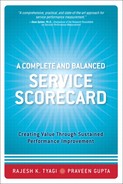As economic focus shifts to service businesses, performance management of service organizations becomes of interest. Most management work has been geared toward businesses comprised of manufacturing supported by associated service operations. Our experience teaches us that as the role of manufacturing in developed or developing economies shifts toward service businesses, performance of services suffer due to ineffective and inefficient management of service resources. For example, customers are more dissatisfied with services in the service economy than with services in the manufacturing economy. There is a consistent and steady decline in the perception of service quality. Customers today get less, and poorer, services in many business sectors—be it telecommunication, fast food, airline, or personal computers—and they feel helpless (Service quality ACSI index of 80.3 in year 1994 compared to an index of 78.3 in year 2004).
Business management for product-driven companies—such as Proctor & Gamble, Motorola, Rubbermaid, Exxon Mobil, Apple, Boeing, or Toyota—is not suitable for companies like Goldman Sachs, Bank of America, American Express, Disney, Starbucks, Southwest, or McKinsey. In other words, service organizations do have their uniqueness that must be managed to achieve sustainable, profitable growth. The main differences between services and manufacturing operations include service focus, interaction with customers and customer participation, job skills, intellectual component, compensation, process and experience management, perception of research and development in services, and performance measurements. Components of the cost of goods sold vary from that of the cost of services due to the lack of physical inventory involved. On the other hand, payroll dollars may be higher for services businesses than the manufacturing business due to the qualification level of service professionals. Even though service functions at the surface level sound and appear to be similar to their manufacturing counterparts, adaptation to service intent becomes an implementation issue that creates a need for the Service Scorecard.
The authors have experience with a variety of scorecards, including the Balanced Scorecard and Six Sigma Business Scorecard, in a variety of industries. Channeling their personal academic and business experience has led them to develop the Service Scorecard. The Service Scorecard builds on the framework used in Six Sigma Business Scorecard, which is a hybrid of Six Sigma and Balanced Scorecard for ensuring completeness and ease of implementation. The authors have written the Service Scorecard book to enable service performance professionals to view their service operations in the business context and manage it for best in class performance. This book benefits from the historical performance management principles and presents the complete model that drives best in class performance, service innovation, and employee engagement. Eventually, service organizations need Service Scorecard to ensure sustained profitable growth for for-profit organizations, or sustained value for not-for-profit organizations. The sustained profitable growth implies that service businesses can grow and make money at the same time, rather than either grow or earn profit year after year through excellence in execution and innovation. Similarly sustained value implies that a not-for-profit must define its value proposition and continue to grow the value creation yearly.
The Service Scorecard book has been organized in three parts.
Part I, “Understanding Service Performance,” builds the background in performance management and presents its challenges. Part I also includes a chapter on Six Sigma for services, which introduces the concepts as the Six Sigma intent as incorporated in the Service Scorecard. The intent of Six Sigma is to accelerate improvement in order to achieve superior and best in class performance. At the end of Part I, you learn about the challenges of service performance management, various performance management models, gaps in performance management for service, and the need for the Service Scorecard.
Part II, “Learning Service Scorecard,” is written to introduce Service Scorecard. You will learn about Service Scorecard concepts and GLACIER elements. GLACIER is an easy way to remember all seven elements: Growth, Leadership, Acceleration, Collaboration, Innovation, Execution, and Retention. In service operations, collaboration and retention are two distinct aspects that differ significantly from manufacturing operations. You learn about the Service Performance Index (SPIN), which is based on the overall performance of the service organization and developed specifically for leadership of the organization for identifying opportunities for performance improvement. By the end of Part II, you will understand the framework of the Service Scorecard, its elements, associated measurements, and their applications for driving organization-wide performance improvement.
Part III, “Practicing Service Scorecard,” focuses on implementation aspects. It covers the step-by-step approach to implementation, integration with various existing improvement initiatives, and best practices for various elements of the Scorecard. Also, validation of the Service Scorecard demonstrates the importance and relevance of each element, and the causal relationship between each element and SPIN, which is a predictor of the service corporation in achieving sustained profitable growth. In identifying best practices, the authors have identified several successful service corporations that use various elements of the Service Scorecard. Practicing all elements in an organization is bound to make the service organization perform at a much higher level, thus making it a profitable and growing organization. Wall Street rewards profitable firms—however, employees love a profitably growing organization as it facilitates their growth and brings out their best. Finally, profitable growing organizations are fun to work for!
